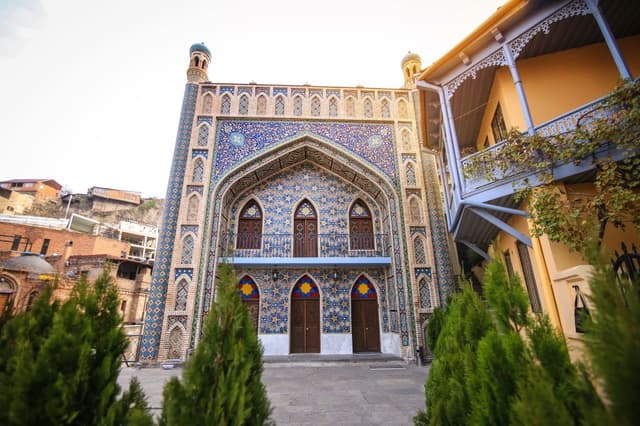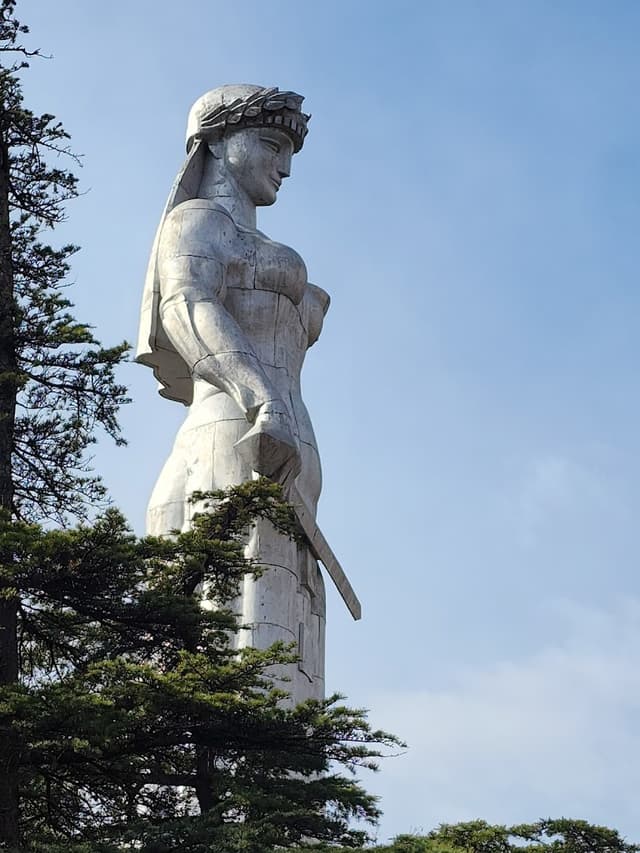Tbilisi with love: the world’s most bohemian city main attractions and hidden gems.
Tbilisi with love: the world’s most bohemian city main attractions and hidden gems.
Elena Nisenbaum
Nestled in the heart of Georgia, Tbilisi stands out as one of the world's most bohemian cities, an intoxicating blend of history, culture, and artistic expression. Its main attractions and hidden gems paint a vivid tapestry of experiences that captivate both the casual traveler and the seasoned adventurer.
Updated ago
4
Share

Main Attractions:

Chreli Abano
@elenanisenbaum
Sulfur Baths located in one of the most unique and recognizable neighborhoods in Tbilisi (Abanotubani). The sulfur baths are a great way to relax, not to mention the countless health benefits that come with them. There is a lot of variety when it comes to choosing which bathhouse to visit, but they all have a shared history.
Abanotubani, literally meaning “bath district”, is an ancient part of Tbilisi, known for its famous brick houses and sulfur bathhouses.
The origin of the bathhouse district dates back to when the city was founded and plays an important part in its history.
According to the legend, when the falcon of King Vakhtang Gorgasali fell in one of the hot springs, the king decided to build the capital on top of the springs.
As a result, Tbilisi earned its name (‘warm place’) from the very same hot springs that ran under the city, and which eventually became the foundation for the bathhouses.
Many of the bathhouses were inspired by traditional Persian-style baths, but the difference is that the water in Tbilisi is not manually heated. Instead, it comes from the ground and is naturally hot.
The sulfur baths have long been very popular. Famous visitors in the past include the legendary Russian poet Alexander Pushkin. During his visit in 1829, complimented them, saying: “Not since I was born have I encountered the luxury of Tiflis’ baths.” And that is a really accurate way of summing them up.
The bathhouses are also said to have countless health benefits. The sulfur in the water helps with dry skin, rashes, joint problems, acne and more.
Add to
Details

Mother of Georgia
@elenanisenbaum
Mother of Georgia as known Kartlis Deda is a monument in Georgia’s capital Tbilisi. The statue was erected on the top of Sololaki hill next to the Narikala Fortress in 1958, the year Tbilisi celebrated its 1500th anniversary. Prominent Georgian sculptor Elguja Amashukeli designed the twenty-meter aluminum figure of a woman in Georgian national dress. Mother of Georgia symbolizes the Georgian national character: in her left hand she holds a bowl of wine to greet those who come as friends, and in her right hand is a sword for those who come as enemies.
The best way to get to the mother of Georgia monument is by the cable car. In addition from the hill, beautiful view of Tbilisi. There are a lot of street musicians who perform sweet music most of the time.
Near the monument Mother of Georgia, you will find Tbilisi Botanical Garden which has a collection of rare plants. Additionally, to hike in the Botanical Garden among the fresh air and pure nature is fun. Also there is a zip line strung from the Narikala Fortress overlooking the city. The track is 30 meters above the park and runs 270 meters to its destination platform in the center of the Garden.
Add to
Details

Lado Gudiashvili Square
@elenanisenbaum
Lado Gudiashvili Square is near Liberty Square, in Tbilisi. It is located at the crossroads of Lermontovi, B. Akhospireli, Gia Abesadze, Abo Tbileli and other streets
One of the historic parts of the Georgian capital of Tbilisi, recently was rehabilitated and restored.
Gudiashvili square is a very peaceful spot in the heart of Old Tbilisi. Here you will find a beautiful fountain of lovers hiding under an umbrella. You can’t find a place much more romantic than that. Relax in the shade from a while and enjoy silence.
The buildings in the Square represented the capital’s rich cultural history. One of the houses served as Imperial Russia’s headquarters for Caucasia in the 19th Century.
Add to
Details

Chronicle of Georgia
@elenanisenbaum
The Chronicle of Georgia is Located on the hills overlooking Tbilisi, the monument is a stunning work of art that celebrates the country’s rich history and cultural heritage. Created by the Georgian sculptor Zurab Tsereteli in 1985, the monument features several large pillars, each depicting important figures and events from Georgian history.
At the center of the monument stands a 30-meter tall pillar featuring a carving of King Mirian III, who played a pivotal role in converting Georgia to Christianity in the 4th century. Surrounding this central pillar are other pillars featuring various other important figures from Georgian history, including Queen Tamar, King David IV, and the poet Shota Rustaveli. The monument is also adorned with beautiful mosaics and frescoes that depict scenes from Georgian mythology and history.
The “Chronicle of Georgia” monument is more than just a work of art, however; it is also a symbol of Georgian national identity and pride. For many Georgians, the monument represents a celebration of their country’s history and culture, as well as a reminder of the important events and figures that have shaped the nation over the centuries.
One of the most striking things about the “Chronicle of Georgia” monument is its sheer size and scale. Standing at over 30 meters tall and covering a large area, the monument is an impressive feat of engineering and artistic skill. Visitors can climb to the top of the monument for a breathtaking view of the surrounding countryside, including the Tbilisi Sea.
You can easily get to the Tbilisi Sea by taxi from city center or from Sarajishvili Metro station if you use mini-bus (Marshutka) #432, it has about 7 stops and is a total of 25 minutes, then you will walk along the footpath in 20 minutes (1.7 km).
Whether you are a history buff, an art lover, or simply a curious traveler, the “Chronicle of Georgia” monument is definitely worth a visit. Its intricate carvings and beautiful mosaics are a testament to the skill and creativity of Georgian artists, and its historical significance is sure to resonate with anyone interested in Georgian culture and history.
Add to
Details
Fabrika: This former Soviet sewing factory has been transformed into a hipster haven, hosting creative spaces, art galleries, bars, and cafes. It's a vibrant hub of modern Tbilisi's artistic spirit
* * *
ABOUT THE AUTHOR
Elena Nisenbaum
A true explorer, I love discovering and seeing beauty, an architecture enthusiast, a fan of delicious coffee, champagne, beautiful nature, and breathtaking views.
Explore related destinations
Read more about places in this guide
Powered by Thatch
The home for unique & authentic travel
The home for unique & authentic travel
Powered by Thatch: Where great trips are made.
© Elena Nisenbaum 2025 • Help • Privacy • Terms • Copyright • Become a Seller • Seller Academy • About • Careers • Blog • Explore Places
Ask ThatchGPT
Ask ThatchGPT
Suggest a local expert to plan my trip
Suggest an unique itinerary for my Tbilisi, Грузия trip
What foods do Tbilisi, Грузия locals eat
What are some true hidden gems in Tbilisi, Грузия
Help me brainstorm trip ideas for Tbilisi, Грузия
Help me plan a family-friendly trip to Tbilisi, Грузия